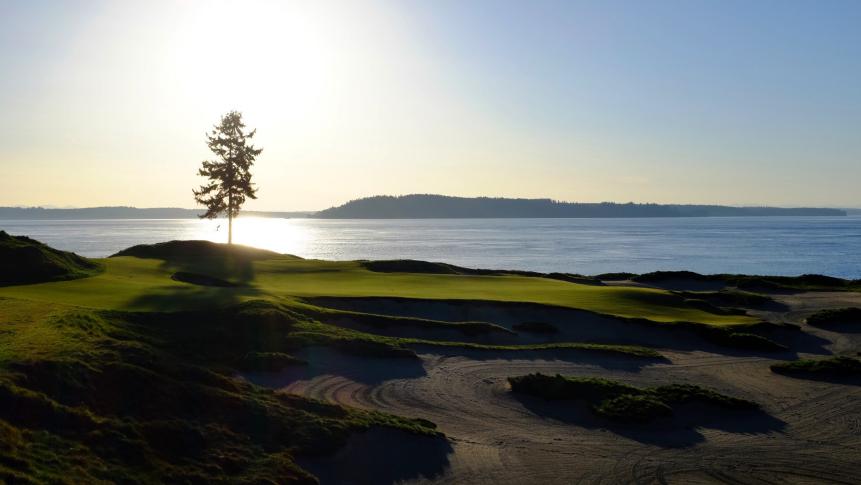USGA
This list of future U.S. Amateur venues will have you working extra hard to lower that handicap index to qualify

Chris Keane
Lining up courses to host major championships well in advance of the year they’re actually being played has become standard operation procedure for the organizing bodies that run these events. The USGA has the U.S. Open booked through 2042, the PGA of America’s next available spot to host a PGA Championship isn’t until 2031 and the Ryder Cup in the U.S. is locked up until 2033. Officials say efficiencies in returning to historic courses, where infrastructure investments can be made that will provide long-term benefits, explain why these groups have been SO proactive in name future sites.
But what about for an event like the U.S. Amateur, the USGA’s oldest championship and arguably the one that golf purists have the softest spot in their hearts for? Sure enough, the USGA has slowly but surely been filling out a dance card for venues that it will bring the Havemeyer Trophy to in the next decade. The latest addition came this week when the USGA announced that Wisconsin’s Whistling Straits will the primary site for the 2028 U.S. Amateur, the only hole in the USGA calendar for the event between now and 2034.
Suffice it to say, the list of courses that lined up as future U.S. Amateur venues is an impressive one, the vast majority ranked among the top 50 on Golf Digest’s America’s 100 Best Courses and all having hosted either the U.S. Amateur or another professional men's major in the past.
As you glance at the list below, you might be like us and wonder about doubling down on practice to somehow get that handicap index below 2.4 in order to be eligible to enter.
2025: Olympic Club
Past U.S. Amateurs: 1958 (Charlie Coe), 1981 (Nathanial Crosby), 2007 (Colt Knost)

2026: Merion Golf Club
Past U.S. Amateurs: 1916 (Chick Evans), 1924 (Bobby Jones), 1930 (Bobby Jones), 1966 (Gary Cowan), 1989 (Chris Patton), 2005 (Edoardo Molinari)

2027: Oak Hill Country Club
Past U.S. Amateurs: 1949 (Charlie Coe), 1998 (Hank Kuehne)

2028: Whistling Straits
Past U.S. Amateurs: N/A

2029: Inverness Club
Past U.S. Amateurs: 1973 (Craig Stadler)

2030: Atlanta Athletic Club
Past U.S. Amateurs: 2014 (Gunn Yang)

2031: The Honors Course
Past U.S. Amateurs: 1991 (Mitch Voges)

2032: Bandon Dunes
Past U.S. Amateurs: 2020 (Tyler Strafaci)

2033: Chambers Bay
Past U.S. Amateurs: 2010 (Peter Uihlein)

Prodded by his partner, Bruce Charlton, and their then-design associate Jay Blasi, veteran architect Robert Trent Jones Jr. agreed to a radically different, vertical-links style when building Chambers Bay in an abandoned sand quarry near Tacoma. By the time Golf Digest named it as America’s Best New Public Course of 2008, the course had already been awarded the 2010 U.S. Amateur and 2015 U.S. Open. In the Amateur, Chambers Bay proved to be hard, both in the firmness of its dry fescue turf (Jones called his fairways, “hardwood floors”) and its difficulties around and on the windswept greens. For the U.S. Open, the firmness and surrounds were more manageable, but the greens were notoriously bumpy. That’s now been remedied, as the fescue turf on the putting surfaces has been replaced with pure Poa Annua. What's irreplacable are the views of Puget Sound from nearly every hole, multi-level fairways that entice bold driving to gain second-shot advantages and two holes running parallel to a railway that's invokes feelings of early Scottish and Irish links courses.
2034: The Country Club
Past U.S. Amateurs: 1910 (William C. Fownes Jr.), 1922 (Jess Sweetser), 1934 (Lawson Little), 1957 (Hillman Robbins), 1982 (Jay Sigel), 2013 (Matt Fitzpatrick)

2036: Scioto Country Club
Past U.S. Amateurs: 1968 (Bruce Fleisher)

2038: Pinehurst No. 2
Past U.S. Amateurs: 1962 (Labron Harris Jr.), 2008 (Danny Lee), 2019 (Andy Ogletree)

2041: Bandon Dunes
Past U.S. Amateurs: 2020 (Tyler Strafaci)

2047: Oakland Hills Country Club
Past U.S. Amateurs: 2002 (Ricky Barnes), 2016 (Curtis Luck)

2051: Saucon Valley Golf Club
Past U.S. Amateurs: 1951 (Billy Maxwell)



